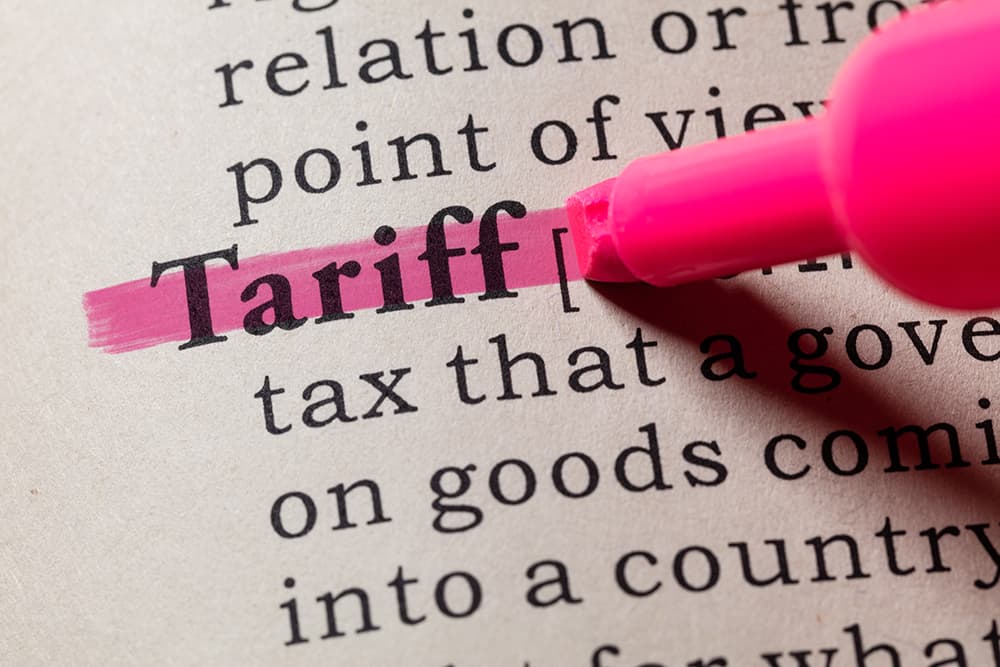A guide to understanding tariffs and duties for your international retail business.

If you are thinking about selling products internationally, you have numerous considerations to keep in mind. Among the most important to prioritize are the tariffs and duties you will be expected to pay. Governed by U.S. cross-border regulations, these financial requirements require ongoing vigilance and adherence.
Taxes defined.
Before you can understand tariffs and duties, you need to know what taxes are. No doubt, you are familiar with the charges the IRS expects you to pay as a consumer and an earner of income.
In general, taxes can be defined as a direct or indirect source of government revenue placed on individuals and goods. They are binding, which means that you are required to pay them. Import taxes are imposed on items coming into the country.
Duties defined.
Duties are indirect taxes that are imposed upon a consumer by the government. They apply to commodities and financial transactions.
Duties can be levied on both imported goods and on things that are locally manufactured. In the case of domestically made products, the tax is known as an excise tax, and the entity that pays it often passes on the cost to their customers.
For imported goods, the government imposes an indirect tax known as a customs tax on the consumer or commercial importer of goods. Often, these taxes are imposed in order to support local industries whose manufacturing costs are higher than those of international producers.
Duties are paid based on measures such as product dimensions, weight, and value and vary by merchandise and country of origin. The United States Customs and Border Protection (CBP) enforces these duties.
Tariffs defined.
Tariffs are direct taxes that are imposed by the government on a specific class of imports or exports. They relate to the harmonized tariff system (HTS) codes that are used to classify imported goods. The exact tariff rate that will be imposed depends on the HTS code under which it falls.
When the government levies a tax on a certain type of imported goods, the price that American consumers pay will almost always rise. When the cost goes up, stock of the item will increase, and the quantity of the goods that are imported will go down.
As a result, international exporters will suffer a loss, domestic producers will experience gains, and the government will bring in additional revenue.
Benefits of tariffs.
In spite of these disadvantages, tariffs offer a number of upsides. They are designed to stimulate domestic employment, which occurs when cheaper international imports are limited. Additionally, the government sometimes institutes tariffs to protect citizens from perceived or real dangers, such as in the event that internationally made goods are tainted in some way.
Tariffs are also imposed if the government is seeking to foster the growth of infant industries until they are more stable and able to support themselves without assistance. Additionally, tariffs can be imposed to promote national security or in retaliation for another country’s actions or political stances.
Types of tariffs and trade barriers.
There are several kinds of tariffs that a government can impose. Specific tariffs are a fixed fee that is levied on one unit of an imported good. Ad valorem tariffs are generated based on a percentage of a good’s value.
In addition to tariffs, the government can also require licenses before a company can import goods and can establish import quotas on the number of products that a business can bring into the country. They can even require that a certain percentage of goods are made locally before anything can be imported from elsewhere.
Duties and tariffs’ effects on your international business.
On the most basic level, duties and tariffs are not voluntary, meaning that you have no choice but to live with them and the consequences that they cause.
Doing your due diligence to learn exactly what you are responsible for paying can go a long way toward protecting your company and allowing you to predict the expenditures you will need to include in your budget and disclose to investors.
International business considerations.
Duties and tariffs are not the only costs you will incur when selling products and services to customers based in other nations. In addition, you will be expected to adhere to the taxes and cross-border regulations that exist in the countries you serve. These often cause you to incur additional expenses over which you have little or no control.
What’s more, you will need to spend money on updating your internal systems to allow for vital functions such as multi-currency payment processing and language translation services. These crucial add-ons allow you to communicate effectively with customers who speak other languages and wish to pay for their purchases using the local currency with which they are most familiar.
Making these updates will mean contacting your international payment processor and could necessitate that you pay to upgrade your point of sale hardware and software. Additionally, you may need to hire local experts to expand your reach and scope with the international buyers you want to attract.
Once you begin to market your products and services to the international market, the benefits will quickly become apparent. Taking this step enables you to sell to a greatly expanded buyer base that may never have been exposed to your specific offerings until now. The result can be significant profits and a vastly expanded reach for your brand.
However, diving into the world of global ecommerce does not come without its pitfalls, particularly those that stem from unexpected financial outlays. When you take the time to understand the duties and tariffs that will apply to your company and the products you sell, you can minimize the element of surprise that can prove so damaging to your ability to budget for the future and pivot as economic changes occur.
Do your research and make smart decisions now, and the deck will be stacked in favor of your global-facing company.






















